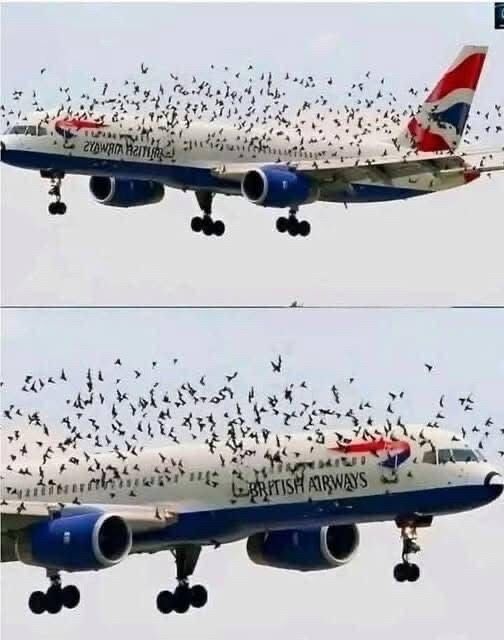Pilot’s Emotional Moment Sparks Viral Story — But What’s the Truth Behind the Birds Flying Alongside a British Airways Plane?

A striking photograph showing hundreds of birds seemingly soaring alongside a British Airways airplane has taken social media by storm — accompanied by an emotional tale that’s touched countless hearts. According to the story, a British Airways pilot named Jason was overwhelmed with emotion upon discovering why this incredible flock was flying so close to his aircraft. The narrative paints a vivid and heartwarming picture, captivating readers worldwide. But as the story spread, so did skepticism about its authenticity.
In March 2024, the fact-checking site Snopes was flooded with questions from curious readers: Was this pilot’s touching experience real, or just another feel-good myth crafted for viral appeal? The story first appeared on happiness-life.org, with a headline promising a powerful revelation: “The pilot’s emotional reaction when he discovered why birds were flying alongside the plane.” The article described a poignant moment, where the pilot’s eyes filled with tears witnessing this rare and breathtaking scene.
The photo itself is undeniably dramatic — hundreds of birds flying in tight formation near a British Airways plane mid-flight. It’s a breathtaking sight that naturally stirs feelings of awe and wonder. Yet, for those familiar with aviation, such an image also raises immediate red flags. Bird strikes—when birds collide with aircraft—are a serious and well-known hazard, especially during takeoff and landing. According to the Aircraft Owners and Pilots Association, nearly 90% of bird strikes occur near airports, posing significant threats to flight safety.
The most famous bird strike story remains that of US Airways Flight 1549. In January 2009, Captain Chesley “Sully” Sullenberger safely ditched his plane on the Hudson River after a flock of geese disabled both engines — a heroic event now known as the “Miracle on the Hudson.” This incident underscores just how dangerous bird encounters can be for pilots and passengers alike.
Against this backdrop, Snopes launched a thorough investigation to separate fact from fiction. They examined aviation records, scrutinized photo archives, and tracked down the image’s origins. What they uncovered was eye-opening.
The dramatic photo didn’t align with typical bird strike scenarios. Closer inspection suggested the image was digitally altered or artistically staged rather than a candid shot of a real event. Additionally, no credible evidence existed to confirm that a British Airways pilot named Jason had ever experienced such a moment. Neither British Airways nor any aviation authorities reported anything remotely similar, and no news sources or official flight logs supported the viral story.
While undeniably touching, the story was ultimately determined to be fictional — a carefully crafted narrative designed to inspire and evoke emotion rather than document reality. This kind of heartwarming yet fabricated content is a common feature of viral posts aimed at captivating audiences with feel-good stories, even when those stories aren’t true.
In the end, the striking image and the pilot’s emotional tale were a powerful reminder of the beauty and wonder people crave — even if that beauty sometimes springs from imagination instead of fact. Snopes’ investigation highlights the need for skepticism and fact-checking in today’s digital world, where images and stories can spread faster than the truth.


